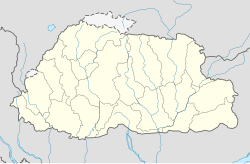| Chagri Dorjeden Monastery Chagri Monastery | |
|---|---|
 | |
| Religion | |
| Affiliation | Tibetan Buddhism |
| Sect | Southern Drukpa Lineage Kagyu |
| Location | |
| Geographic coordinates | 27°35′54″N89°38′50″E / 27.59833°N 89.64722°E |
| Architecture | |
| Founder | Ngawang Namgyal |
| Date established | 1620 |
Chagri Dorjeden Monastery, also called Cheri Monastery, is a Buddhist monastery in Bhutan established in 1620 by Ngawang Namgyal, 1st Zhabdrung Rinpoche, [1] the founder of the Bhutanese state.
Contents
The monastery, now a major teaching and retreat center of the Southern Drukpa Lineage of the Kagyu school of Tibetan Buddhism, is located at the northern end of the Thimphu Valley about 15 kilometres (9.3 mi) from the capital. It sits on a hill above the end of the road at Dodeyna and it takes about an hour to walk up the steep hill to reach the monastery from there.
According to Bhutanese religious histories, the place was first visited by Padmasambhava in the 8th century. In the 13th century it was visited by Phajo Drugom Zhigpo the Tibetan Lama who first established the Drukpa Kagyu tradition in Bhutan. Johnsingh (2005) describes the beauty of the place and the occurrence of goral there.

| Part of a series on |
| Tibetan Buddhism |
|---|
 |
Chagri Dorjeden was the first monastery established in Bhutan by Ngawang Namgyal in 1620 when he was 27 years old. The Zhabdrung spent three years in a strict retreat at Chagri and resided there for many periods throughout the rest of his life. It was at Chagri in 1623 that he established the first Drukpa monastic order in Bhutan.
In 1705, the 7th Druk Desi, Umze Peljor, retired to Chagri Monastery, where he lived until he died in 1707. [2]
